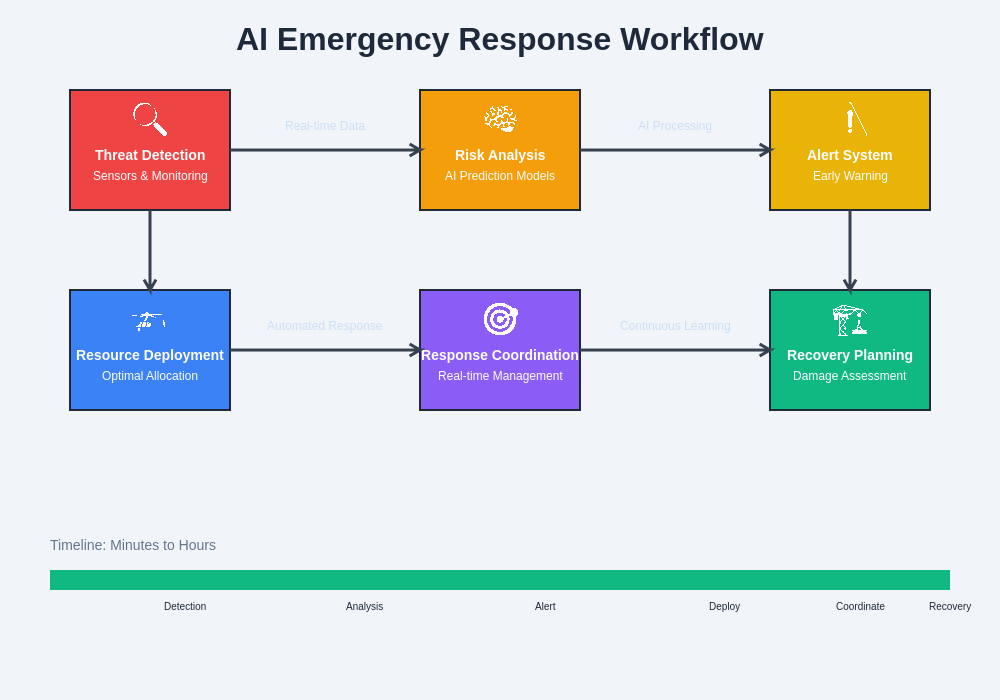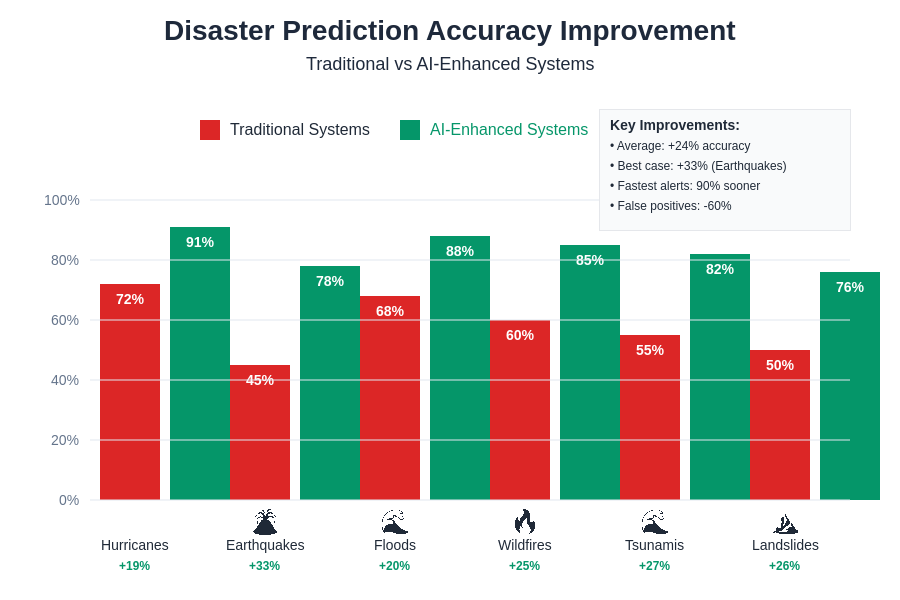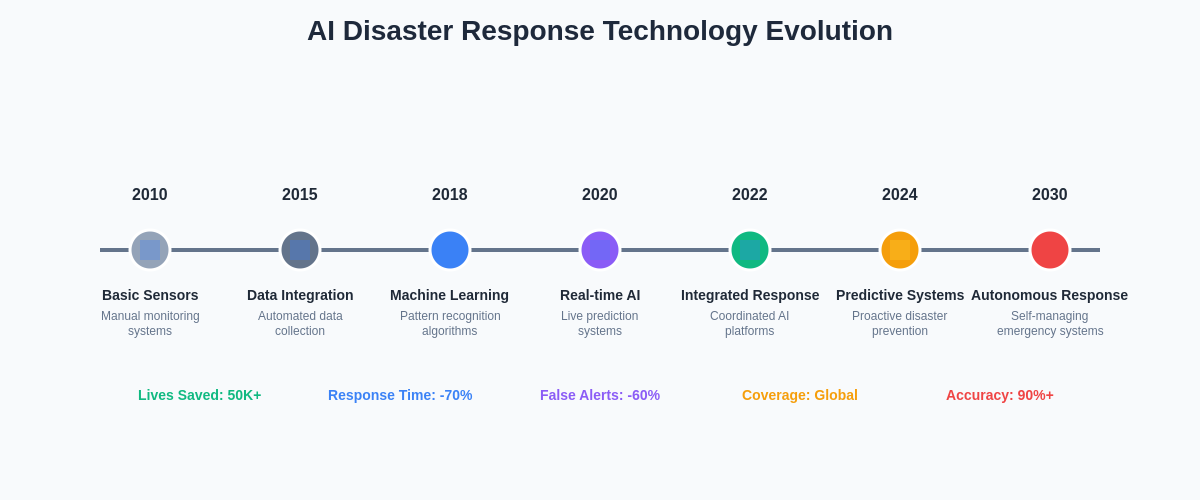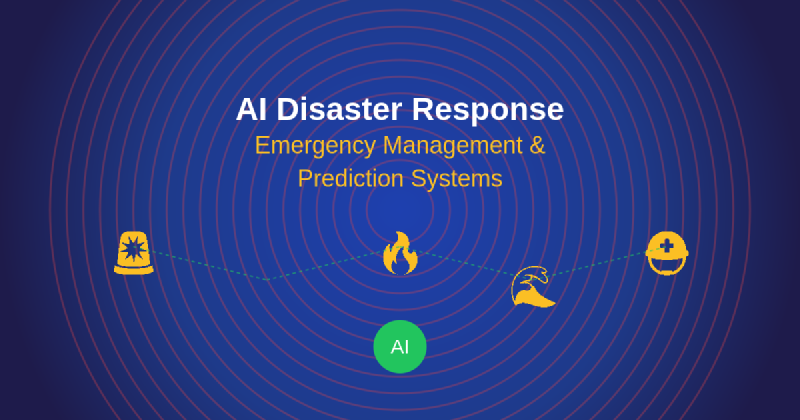In an era where natural disasters are becoming increasingly frequent and severe, artificial intelligence has emerged as a critical ally in protecting human lives and minimizing catastrophic damage. The integration of AI technologies into disaster response and emergency management systems represents a transformative shift from reactive crisis management to proactive prediction and prevention strategies. These sophisticated systems leverage vast amounts of data, advanced machine learning algorithms, and real-time processing capabilities to create comprehensive emergency response frameworks that can anticipate, prepare for, and effectively manage disaster scenarios with unprecedented accuracy and speed.
Stay updated with the latest AI innovations that are reshaping how we approach crisis management and emergency response systems. The convergence of artificial intelligence with disaster management represents one of the most impactful applications of AI technology, directly contributing to the preservation of human life and the protection of critical infrastructure during times of crisis.
The Evolution of Disaster Response Technology
Traditional disaster response systems relied heavily on historical data, manual observation, and human judgment to assess threats and coordinate emergency responses. While these approaches provided valuable foundations for emergency management, they were often limited by processing speed, human error, and the inability to analyze complex patterns across multiple data sources simultaneously. The introduction of AI technologies has fundamentally transformed this landscape by enabling real-time data processing, predictive modeling, and automated decision-making capabilities that far exceed human analytical capacity.
Modern AI-powered disaster response systems integrate satellite imagery, weather data, seismic monitoring, social media feeds, and countless other data sources to create comprehensive situational awareness platforms. These systems can identify emerging threats hours or even days before they become critical, allowing emergency management teams to implement preventive measures, evacuate populations, and deploy resources with remarkable precision and timing.
Predictive Analytics and Early Warning Systems
The cornerstone of AI-driven disaster management lies in its predictive capabilities, which utilize sophisticated machine learning algorithms to analyze historical patterns, current conditions, and emerging trends to forecast potential disaster scenarios. These predictive models incorporate meteorological data, geological measurements, hydrological information, and environmental indicators to create highly accurate forecasts of natural disasters including hurricanes, earthquakes, floods, wildfires, and severe weather events.
Advanced neural networks and deep learning systems continuously process streams of real-time data from thousands of sensors, satellites, and monitoring stations to identify subtle patterns and anomalies that may indicate impending disasters. These systems can detect changes in atmospheric pressure, ground movement, water levels, temperature fluctuations, and countless other variables that serve as precursors to natural disasters, enabling emergency management teams to issue warnings and implement protective measures well in advance of actual events.
Explore advanced AI capabilities with Claude for comprehensive analysis and decision-making support in complex emergency scenarios. The ability to process and analyze vast amounts of disparate data sources simultaneously has revolutionized our capacity to predict and prepare for natural disasters with unprecedented accuracy and lead time.
Real-Time Monitoring and Situational Awareness
AI-powered emergency management systems excel at maintaining comprehensive situational awareness during active disaster events through continuous monitoring and real-time data analysis. These systems integrate multiple data streams including satellite imagery, drone surveillance, ground-based sensors, social media monitoring, emergency service communications, and citizen reporting platforms to create dynamic, real-time maps of disaster impact and emergency response activities.
Machine learning algorithms process this continuous stream of information to identify areas of greatest need, track the movement and intensity of disaster events, monitor evacuation progress, and assess the effectiveness of ongoing response efforts. This real-time situational awareness enables emergency coordinators to make informed decisions about resource allocation, evacuation routes, shelter locations, and rescue priorities based on current conditions rather than outdated or incomplete information.
Intelligent Resource Allocation and Logistics
One of the most challenging aspects of disaster response involves efficiently allocating limited resources across multiple competing priorities while dealing with rapidly changing conditions and incomplete information. AI systems have revolutionized this process by implementing sophisticated optimization algorithms that can simultaneously consider hundreds of variables including resource availability, transportation constraints, population density, vulnerability assessments, and predicted disaster progression to determine optimal resource deployment strategies.
These intelligent allocation systems can automatically coordinate the deployment of emergency personnel, medical supplies, food and water resources, temporary shelters, and heavy equipment to maximize their effectiveness and minimize response times. The systems continuously adjust these allocations as conditions change, ensuring that resources are always deployed where they can have the greatest impact on saving lives and reducing suffering.

The integrated approach to emergency response management demonstrates how AI systems coordinate multiple aspects of disaster response simultaneously, from initial threat detection through recovery operations. This comprehensive workflow ensures that all critical elements of emergency response are addressed systematically and efficiently.
Advanced Communication and Coordination Systems
Effective disaster response requires seamless communication and coordination among multiple agencies, organizations, and response teams operating in chaotic and rapidly changing environments. AI-powered communication systems have addressed these challenges by creating intelligent coordination platforms that automatically route information to appropriate recipients, prioritize critical communications, and maintain operational awareness across all response teams.
These systems utilize natural language processing to analyze emergency communications, automatically extract critical information, and distribute relevant updates to appropriate personnel based on their roles and responsibilities. Machine learning algorithms continuously monitor communication patterns to identify potential coordination gaps, communication bottlenecks, and information sharing opportunities that can improve overall response effectiveness.
Satellite Imagery and Remote Sensing Analysis
The integration of AI with satellite imagery and remote sensing technologies has created powerful capabilities for disaster assessment and response planning. Machine learning algorithms can automatically analyze satellite images to assess damage levels, identify blocked roads and damaged infrastructure, locate populations in need of assistance, and track changes in disaster-affected areas over time. These capabilities are particularly valuable in situations where ground-based assessment teams cannot safely access affected areas.
Computer vision systems trained on vast datasets of disaster imagery can instantly recognize signs of structural damage, flooding, fire damage, landslides, and other disaster impacts with accuracy levels that often exceed human assessment capabilities. This automated analysis enables rapid damage assessment and helps emergency managers prioritize response efforts based on objective, comprehensive evaluations of disaster impact.
Discover powerful research capabilities with Perplexity for accessing critical information and analysis during emergency situations when rapid decision-making is essential. The combination of multiple AI tools creates a comprehensive intelligence ecosystem that supports every aspect of disaster response and emergency management.
Social Media Monitoring and Crowd-Sourced Intelligence
Social media platforms have become invaluable sources of real-time information during disaster events, providing firsthand accounts, images, and updates from affected populations. AI systems have been developed to continuously monitor social media streams, automatically identify disaster-related content, and extract actionable intelligence that can inform response efforts. Natural language processing algorithms can analyze text content to identify specific needs, locate people requiring assistance, and track the progression of disaster impacts across different geographic areas.
These crowd-sourced intelligence systems can process thousands of social media posts, images, and videos per minute to identify emerging needs, verify reported incidents, and provide emergency managers with comprehensive awareness of conditions on the ground. Machine learning algorithms filter out irrelevant content and focus on information that has direct relevance to emergency response operations, ensuring that decision-makers receive timely and accurate intelligence from affected communities.
Healthcare System Integration and Medical Response
AI technologies have significantly enhanced emergency medical response capabilities by integrating hospital capacity monitoring, patient tracking, medical supply management, and treatment optimization into comprehensive healthcare emergency management systems. These systems can predict medical needs based on disaster type and severity, automatically coordinate patient transfers between medical facilities, and optimize the allocation of medical personnel and resources across affected areas.
Machine learning algorithms analyze patient symptoms, injury patterns, and treatment outcomes to optimize medical protocols for disaster-related injuries and illnesses. These systems can also predict potential public health threats that may emerge following disasters, such as disease outbreaks, water contamination, or mental health crises, enabling proactive medical interventions that prevent secondary health emergencies.
Infrastructure Protection and Critical System Monitoring
AI-powered systems play crucial roles in protecting critical infrastructure during disaster events by continuously monitoring power grids, transportation networks, communication systems, water treatment facilities, and other essential services. These systems can automatically detect infrastructure failures, predict potential cascade effects, and implement protective measures to minimize service disruptions during disasters.
Smart grid management systems utilize AI to automatically reroute power distribution around damaged components, prioritize power restoration to critical facilities, and optimize energy allocation during emergency situations. Similarly, transportation management systems can dynamically adjust traffic patterns, recommend optimal evacuation routes, and coordinate emergency vehicle routing to ensure efficient movement of people and resources during disaster responses.

The substantial improvements in disaster prediction accuracy demonstrate the transformative impact of AI technologies across different types of natural disasters. These enhanced prediction capabilities translate directly into saved lives and reduced property damage through improved preparation and response times.
Search and Rescue Operations Enhancement
AI technologies have revolutionized search and rescue operations by enabling more efficient coordination of rescue teams, optimizing search patterns, and improving the likelihood of locating survivors in disaster-affected areas. Machine learning algorithms can analyze terrain data, weather conditions, survivor behavior patterns, and historical rescue data to predict optimal search areas and recommend deployment strategies for rescue teams.
Drone-based AI systems equipped with thermal imaging, computer vision, and communication capabilities can autonomously search large areas for survivors, identify signs of human presence, and relay critical information back to rescue coordination centers. These systems can operate in conditions that may be too dangerous for human rescue teams while providing continuous coverage of affected areas throughout day and night operations.
Climate Change Adaptation and Long-term Planning
AI systems are increasingly being utilized for long-term disaster preparedness and climate change adaptation planning by analyzing historical climate data, current environmental trends, and projected future conditions to identify emerging risks and recommend adaptive strategies. These systems can model the potential impacts of changing climate patterns on disaster frequency and severity, helping communities develop comprehensive preparedness plans that account for evolving risk profiles.
Machine learning algorithms analyze vast datasets of climate information, population growth patterns, infrastructure development, and environmental changes to predict how disaster risks may evolve over time. This long-term planning capability enables communities to make informed decisions about land use planning, infrastructure investments, and emergency preparedness strategies that will remain effective as climate conditions continue to change.
Economic Impact Assessment and Recovery Planning
The economic dimensions of disaster response and recovery have been significantly enhanced through AI-powered analysis systems that can rapidly assess economic impacts, predict recovery timelines, and optimize resource allocation for maximum economic resilience. These systems analyze business disruptions, infrastructure damage, employment impacts, and supply chain interruptions to provide comprehensive economic impact assessments that inform recovery planning decisions.
AI algorithms can model different recovery scenarios, predict the effectiveness of various economic support measures, and recommend strategies for accelerating economic recovery while building greater resilience against future disasters. These capabilities help governments and organizations make informed decisions about disaster recovery investments and policies that maximize long-term community resilience.
International Cooperation and Information Sharing
AI systems have facilitated unprecedented levels of international cooperation in disaster response by enabling real-time information sharing, coordinating multinational response efforts, and standardizing disaster assessment and response protocols across different countries and organizations. Machine learning algorithms can automatically translate emergency communications, standardize data formats, and facilitate seamless information exchange between response organizations operating in different languages and using different systems.
These international cooperation platforms enable rapid deployment of international assistance, coordinate multinational rescue operations, and share critical resources and expertise across borders during major disaster events. The systems can automatically identify available international resources, match them with specific needs in disaster-affected areas, and coordinate logistics for rapid international response deployment.
Privacy, Ethics, and Data Security Considerations
The implementation of AI in disaster response raises important questions about privacy protection, ethical data use, and information security that must be carefully balanced against the urgent need to protect human life during emergency situations. AI systems often require access to vast amounts of personal information, location data, and sensitive communications to operate effectively, creating potential risks for privacy violations and data misuse if not properly managed.
Ethical frameworks for AI disaster response must address issues such as algorithmic bias in resource allocation decisions, transparency in automated decision-making processes, and accountability for AI-driven response actions that may have significant consequences for affected populations. These considerations require ongoing dialogue between technology developers, emergency management professionals, privacy advocates, and affected communities to ensure that AI systems serve the public interest while respecting individual rights and community values.

The evolution of AI disaster response technologies demonstrates the rapid advancement from basic data analysis to sophisticated prediction and coordination systems. This technological progression has dramatically improved our collective ability to prevent, prepare for, and respond to natural disasters and emergency situations.
Future Developments and Emerging Technologies
The future of AI disaster response will likely involve even more sophisticated integration of emerging technologies including quantum computing, advanced robotics, augmented reality, and next-generation sensor networks. Quantum computing systems may enable real-time processing of vastly larger datasets and more complex modeling scenarios, while advanced robotics could provide autonomous response capabilities in environments too dangerous for human responders.
Augmented reality systems could enhance situational awareness for emergency responders by overlaying critical information directly onto their field of vision, while next-generation sensor networks could provide unprecedented granularity in environmental monitoring and threat detection. These emerging technologies will likely create new possibilities for disaster prevention, response, and recovery that we can only begin to imagine today.
Training and Capacity Building
The successful implementation of AI disaster response systems requires comprehensive training programs and capacity building initiatives that ensure emergency management professionals can effectively utilize these powerful technologies. Training programs must address both technical aspects of AI system operation and the strategic implications of AI-enhanced decision-making in emergency situations.
Capacity building efforts must also address the need for interdisciplinary collaboration between AI technologists, emergency management professionals, public policy experts, and community leaders to ensure that AI systems are developed and deployed in ways that truly serve community needs and enhance overall disaster resilience.
Community Engagement and Public Awareness
Effective AI disaster response systems require active community engagement and public awareness programs that help citizens understand how these technologies work, what benefits they provide, and how community members can contribute to their effectiveness. Public education initiatives must address potential concerns about privacy and surveillance while highlighting the life-saving benefits of AI-enhanced emergency management systems.
Community engagement programs can also help identify local knowledge and resources that can enhance AI system effectiveness while building trust and cooperation between technology systems and the communities they serve. This collaborative approach ensures that AI disaster response systems reflect community values and priorities while maximizing their effectiveness in protecting lives and property.
The integration of artificial intelligence into disaster response and emergency management represents one of the most promising applications of AI technology for directly improving human welfare and safety. As these systems continue to evolve and mature, they promise to create increasingly effective capabilities for predicting, preventing, and responding to natural disasters and emergency situations. The continued development of these technologies, combined with appropriate ethical frameworks and community engagement strategies, offers hope for a future where the devastating impacts of natural disasters can be significantly reduced through intelligent, proactive, and coordinated response systems that leverage the full potential of artificial intelligence to protect and serve human communities around the world.
Disclaimer
This article is for informational purposes only and does not constitute professional advice regarding emergency management or disaster response procedures. The views expressed are based on current understanding of AI technologies and their applications in emergency management. Readers should consult with qualified emergency management professionals and follow official emergency protocols established by relevant authorities. The effectiveness of AI systems may vary depending on specific circumstances, available data, and implementation approaches.
